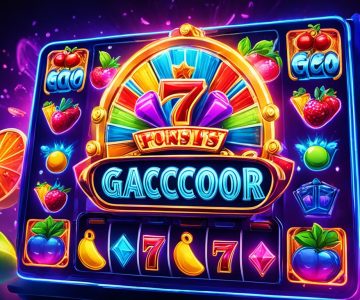Slot RTP Hot Explained: Maximizing Your Winning Potential
Slot RTP Hot refers to slot games that offer a higher statistical return to player (RTP) percentage compared to average. These games provide better chances of payout over time, making them more attractive to players seeking greater value from their bets. RTP is a key factor for anyone looking to understand how much a slot might pay back relative to what is wagered.
Slots labeled as “hot” often have RTP values above the standard range, sometimes exceeding 96% or more. This does not guarantee a win on every spin but indicates a favorable long-term return. Understanding hot slots can help players make informed choices instead of relying on chance alone.
Knowing which slots have higher RTP rates, like those exceeding 96%, can improve the gaming experience by aligning expectations with the game’s payout structure. Players who prioritize RTP tend to focus on these hot slots because they balance risk with a higher likelihood of returns.
Understanding Slot RTP Hot
Slot RTP Hot involves specific aspects of Return to Player (RTP) rates and how they relate to slot machines that appear to be “hot.” This section explores the definition of the term, the impact RTP has on gameplay, and the key differences between hot slots and regular slots.
Definition of Slot RTP Hot
Slot RTP Hot refers to slot machines that have high Return to Player percentages combined with recent higher-than-average payouts. RTP indicates the expected percentage of wagered money a slot returns to players over time.
A “hot” slot is often thought to be one currently paying out more frequently or in larger amounts. The term “hot” relates more to short-term results, while RTP is a theoretical long-term average.
Together, “Slot RTP Hot” describes games that not only have a favorable RTP—typically above 96%—but are also believed to be in a winning streak based on recent activity.
How RTP Influences Slot Gameplay
RTP is a theoretical measure of how much money a slot returns to players across many spins.
A higher RTP generally means players have a better chance of retaining some funds over extended play. For example, a slot with a 96% RTP returns $96 for every $100 wagered on average.
However, RTP does not predict short-term outcomes or guarantee wins. The actual gameplay experience depends on volatility, which affects the frequency and size of payouts.
Players often choose games with above-average RTP values to maximize potential returns while understanding that variance heavily influences immediate results.
Differences Between Hot Slots and Standard Slots
Hot slots are perceived to be on a winning streak because they give out frequent or substantial payouts in a short time.
Standard slots, regardless of their RTP, do not show these recent payout patterns and may appear “cold” or less rewarding temporarily.
The key difference is that RTP is fixed and based on a large number of spins, while a hot slot refers to shorter-term payout trends, which are random and can change quickly.
Choosing a hot slot involves looking for signs of recent activity, but it does not alter the machine’s programmed RTP or long-term odds of winning.
How RTP Affects Slot Performance
The Return to Player (RTP) percentage is a critical factor in how slot machines behave over time. It influences the amount players can expect to win back and plays a key role in the frequency and size of payouts. Understanding RTP helps in assessing slot performance and player experience.
The Role of RTP in Payouts
RTP represents the average percentage of wagered money a slot will return to players over a long period. For example, a slot with a 96% RTP theoretically pays back $96 for every $100 wagered. This figure is calculated over millions of spins, not within a short gaming session.
Higher RTP means the slot retains less of the wagered money as profit, increasing player return. However, RTP does not guarantee short-term wins or losses. It is a long-term statistical expectation that impacts overall profitability but not specific game outcomes.
Importance of High RTP Rates
A high RTP rate generally corresponds to better chances of winning back wagers over time. Slots with RTP above 95% are considered more favorable because they return a larger portion of the money wagered.
High RTP slots tend to attract players seeking more consistent returns. However, players should remember that RTP does not affect the volatility or the size and frequency of individual wins. It mainly dictates the theoretical payout over extensive gameplay.
Variability of RTP in Online Slots
RTP in online slots can sometimes change based on the bet size or game version, but this is not always the case. Some games have fixed RTP values regardless of bet amounts, while others vary slightly with different bet levels or bonus features.
Online slots often display their RTP rates openly for transparency. Players can compare these percentages to choose games that suit their risk tolerance and gameplay style. Understanding RTP variability helps manage player expectations during sessions.
Identifying Hot RTP Slots
Finding slots that consistently offer favorable returns requires attention to specific payout patterns, the game’s theoretical return rate, and reliable tracking methods. Understanding these elements helps distinguish genuinely “hot” slots from those merely appearing active.
Indicators of a Hot Slot
A “hot” slot is often one that pays out frequently or has recently produced significant wins. Players observe shorter intervals between payouts and noticeable bonus rounds triggered more often than usual.
However, this pattern is based on short-term variance and does not guarantee future results. Another key factor is the slot’s Return to Player (RTP) percentage; machines with an RTP above 96% tend to offer better long-term returns.
Players can also consider volatility levels—medium to low volatility slots balance frequency and size of wins, often appearing “hot” more consistently than high volatility games.
Slot RTP Tracking Tools
Tracking tools and software provide detailed records of slot payouts and RTP trends over time. Many online platforms include built-in RTP information accessible through the game’s info screen or help menu.
Third-party tracking websites and apps analyze thousands of spins, presenting RTP averages and recent hit frequencies. They allow players to compare games based on real data rather than anecdotal evidence.
Using these tools, players can filter by RTP percentage, volatility, and payout history. This helps identify slots with a higher likelihood of maintaining favorable payout behaviors across sessions.
Popular Hot RTP Slot Titles
Several well-known slots combine high RTP percentages with active payout histories, making them popular among players seeking hot machines.
| Slot Title | RTP Percentage | Volatility | Notable Features |
|---|---|---|---|
| Starburst | 96.09% | Low | Frequent small wins |
| Blood Suckers | 98.00% | Low | High hit rate, bonus rounds |
| Gonzo’s Quest | 96.00% | Medium | Avalanche wins, multipliers |
| Jackpot 6000 | 98.90% | High | Classic design, big jackpots |
These titles are widely recognized for their consistent payout records and above-average RTP. Players looking for “hot” RTP slots often start their search here due to their reliable statistics and gameplay features.
Strategies for Playing Hot RTP Slots
Maximizing gains on hot RTP slots requires careful money control and understanding when to engage with the games. Players need a precise approach to both managing their budget and pacing their play to align with the slot’s payout rhythm.
Bankroll Management Tips
Players should set a strict budget before starting. Allocating a fixed amount limits losses and helps maintain control without chasing losses. Dividing the bankroll into smaller sessions can prevent rapid depletion.
Adjusting bet sizes based on wins and losses is vital. Increasing bets slightly after small wins can capitalize on streaks, but reducing bets after losses protects the bankroll. Keeping bets within 1-5% of the total bankroll is advisable to sustain longer play.
Tracking wins and losses during the session allows timely decisions to stop or continue. Knowing when to quit is critical; stopping after a significant win preserves profit and avoids giving it back to the house.
Timing and Frequency Considerations
High RTP does not guarantee immediate returns. Players should focus on consistent, steady gameplay rather than chasing quick wins. Playing too frequently or across multiple machines increases exposure to losses rather than capitalizing on RTP advantages.
Timing sessions with breaks is recommended. Short, focused play sessions prevent fatigue and impulsive decisions. Monitoring the slot’s payout history (if available) can help identify favorable windows, but players should avoid superstition like hot or cold streak myths.
Limiting playtime helps contain risk. Sessions of 30-60 minutes strike a good balance between engagement and control, reinforcing disciplined play without overexposure.
Choosing Reliable Slot Providers
Choosing a slot provider requires checking their reputation and the fairness of their games. Key aspects include the developers behind the slots and the certifications verifying payout accuracy.
Trusted Slot Developers
Reliable slot providers have a strong track record in the iGaming industry. Names like NetEnt, Microgaming, Playtech, and Pragmatic Play are known for consistent quality and innovation. They continuously update their game libraries while maintaining player trust.
Reputation matters. Providers with positive user reviews and long-term presence tend to offer stable RTP rates and fewer technical issues. Partnering with well-known casinos also signals reliability.
Players should look for features such as frequent game updates, transparent RTP disclosures, and bonuses aligned with the provider’s games. Developers that prioritize fairness and user experience are preferable.
Certifications and RTP Audits
Certifications from independent testing agencies are crucial for verifying a slot’s RTP (Return to Player) rates. Organizations like eCOGRA, iTech Labs, and GLI conduct audits to confirm game fairness.
These audits ensure that RTP percentages are accurate and not manipulated. A certified RTP typically ranges above 96%, which is considered good. Players should check that the games are audited regularly.
Casinos and providers must display these certifications clearly. This transparency helps players make informed choices and trust that their chances of winning match stated probabilities.
Common Myths About Slot RTP Hot
Some beliefs around slot RTP and “hot” machines stem from misunderstandings about how payout rates work and the role of randomness. Clarifying these points helps players avoid false expectations and approach slots with accurate knowledge.
RTP and Short-Term Results
Return to Player (RTP) percentage is a long-term average, calculated over thousands or millions of spins. It does not guarantee a specific return in a single session or short period of play.
A slot with a 96% RTP means that, theoretically, it will pay back £96 for every £100 wagered over a very large number of spins. In the short term, results can vary widely, with players sometimes winning a lot or losing their bets quickly.
Expecting RTP to reflect immediate outcomes is incorrect. RTP is a statistical measure, not a promise about any one spin or short series of spins.
Randomness Versus Payout Cycles
Slot machines use Random Number Generators (RNGs) to determine each spin outcome independently. This means past results do not affect future spins, making the concept of “hot” or “cold” machines invalid.
Players cannot predict or influence when a slot “pays out” because every spin is random and unrelated to previous spins. There is no fixed cycle or pattern to payouts.
Believing that a machine is “due” for a win ignores the RNG’s design to produce unpredictable outcomes. Winning or losing streaks are random and not tied to the game’s RTP or internal payout schedule.
Regulations and Fairness in Slot RTP
Slot RTP is regulated to ensure fairness and protect players. These regulations depend heavily on licensing authorities and independent testing agencies. Both work to guarantee that RTP values are accurate, consistent, and transparent for all slot games.
How Licensing Affects RTP
Licensing agencies impose strict rules on casinos and game providers regarding RTP disclosure and fairness. They require operators to meet minimum RTP standards, which typically range from 90% to 96% depending on jurisdiction.
Licenses from respected authorities like the UK Gambling Commission or Malta Gaming Authority enforce regular audits. These audits check whether slot machines adhere to declared RTP rates, preventing operators from altering RTP settings arbitrarily.
Licensed casinos must publish RTP information clearly, allowing players to make informed choices. Regulatory bodies can sanction or revoke licenses if operators fail to comply with RTP regulations, reinforcing integrity in the games offered.
Testing Agencies and Transparency
Independent testing agencies play a crucial role in verifying RTP claims from game developers. Organizations such as eCOGRA and iTech Labs rigorously test slot software using statistical models over millions of spins.
These agencies analyze whether the actual RTP aligns with published figures and check for random number generator (RNG) fairness. Their certification signals that the game operates as advertised without manipulation.
Transparency is improved when casinos display these certifications on their sites, building trust with players. Testing reports are often publicly accessible, giving detailed breakdowns of RTP percentages and volatility levels for each slot title.
Trends in Hot Slot Games
Slot games have seen notable changes in both technology and player preferences. These shifts influence RTP values and how developers design engaging experiences that balance fairness and excitement.
Recent Innovations Affecting RTP
Developers increasingly focus on optimizing RTP (Return to Player) to attract players while managing game profitability. Modern slots often feature RTP rates around 93% to 98%, with titles like Blood Suckers reaching near 98%.
Variable RTP mechanics are gaining popularity, allowing dynamic adjustment of payout percentages during gameplay. This adds unpredictability without straying far from calculated odds.
Improved game volatility management also shapes RTP trends. High volatility games offer larger but less frequent wins, while low volatility games provide steady but smaller payouts. This variety caters to diverse player appetites and risk profiles.
Player Preferences and Demand
Players now demand transparency and fairness, paying close attention to RTP percentages before choosing games. Slots promising higher RTP often attract more consistent play.
Social casino platforms emphasize popular games with steady RTP, contributing to their sustained appeal. Titles from developers like Pragmatic Play and NetEnt remain favorites due to their blend of engaging gameplay and reliable RTP.
Additionally, players show interest in slots with thematic innovation and bonus features without sacrificing RTP. This trend encourages developers to balance entertainment with statistically sound payout models.
Responsible Gaming with Hot RTP Slots
Playing slots with high RTP values requires careful attention to managing time, money, and behavior. Maintaining control improves the experience and reduces the likelihood of negative consequences.
Setting Limits
Players should establish clear monetary limits before starting to play hot RTP slots. These include:
- Deposit limits: The maximum amount deposited in a set period
- Loss limits: The total amount a player is willing to lose
- Wager limits: Caps on individual bet sizes
Using these limits helps prevent overspending and keeps gambling within affordable boundaries. Many online casinos offer built-in tools for setting these controls to support responsible play.
Time limits are equally important. Scheduling breaks and setting session time caps helps avoid extended play, which can impair judgment. Sticking to limits prevents chasing losses, which often leads to larger losses.
Recognizing Risk Factors
Players need to be aware of personal risk factors that can increase vulnerability while playing hot RTP slots. These include:
- Chasing losses: Trying to recoup money quickly after losing
- Playing under stress or fatigue: Impairs decision-making
- Gambling to escape problems: Indicates unhealthy coping
Physical and emotional signs like irritability, restlessness, or neglecting responsibilities are important signals to pause play.
Understanding that even slots with high RTP cannot guarantee winnings over the short term is crucial. RTP reflects long-term averages but does not influence individual sessions. Awareness of this helps manage expectations and avoid risky behaviors.




